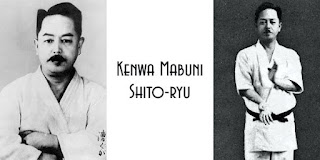Kenwa Mabuni by Neil Horton
Kenwa Mabuni
Born in Shuri on Okinawa in 1889, Mabuni Sensei was a family descendant of the famous Onigusukini Samurai family. He was said to be a weak and frail child, so he commenced the instruction in his home town in the art of Shuri-Te at the age of 13. Mabuni was taken under the tutelage of the legendary Ankō Itosu (1813-1915). He trained diligently for several years, learning many kata from this great master.
Sensei Chōjun Miyagi (founder of Gōjū-ryū) was a close friend and introduced Mabuni to another great of that period, Sensei Higaonna Kanryō and it was here he began to learn Naha-Te under him as well. While both Itosu and Higashionna taught a 'hard-soft' style of Okinawan 'Te', their methods and stresses were quite distinct: the Itosu syllabus included straight and powerful techniques as exemplified in the Naifanchi and Bassai kata; the Higashionna syllabus, on the other hand, stressed circular motion and shorter fighting methods as seen in the popular Seipai and Kururunfa forms.
Shitō-ryū focuses on both hard and soft techniques to this day. Kenwa Mabuni did distinctively remain true to the teachings of these two great masters, however he sought instruction from a number of other teachers; including Seishō Aragaki, Tawada Shimboku, Sueyoshi Jino and Wu Xianhui (a Chinese master known as Go-Kenki). In fact, Mabuni was extremely well noted and highly respected for his encyclopaedic knowledge of kata and their bunkai applications.
By the 1920s, he was regarded as the foremost authority on Okinawan kata and their history and was much sought after as a teacher by his contemporaries.



Comments
Post a Comment